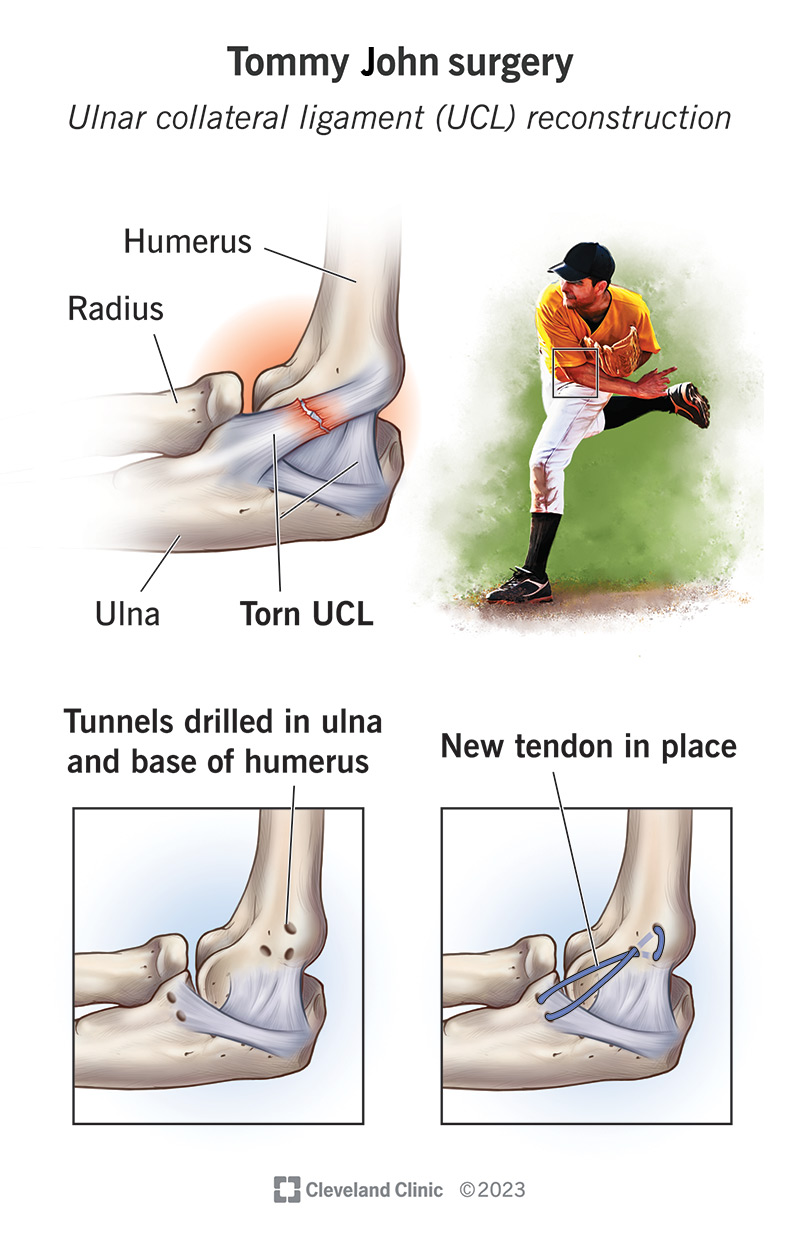Tommy John surgery is reconstruction of your UCL (ulnar collateral ligament). This is the ligament in your elbow that helps you throw. The surgery is named after MLB pitcher Tommy John. It usually takes around a year to recover from UCL surgery. But most people are able to return to play once their elbows heal.
Advertisement
Cleveland Clinic is a non-profit academic medical center. Advertising on our site helps support our mission. We do not endorse non-Cleveland Clinic products or services. Policy

Tommy John surgery is a procedure to repair your ulnar collateral ligament. It’s also known as UCL surgery or UCL reconstruction.
Advertisement
Cleveland Clinic is a non-profit academic medical center. Advertising on our site helps support our mission. We do not endorse non-Cleveland Clinic products or services. Policy
Your ulnar collateral ligament is a strong band of tissue on the inside of your elbow. Ulnar collateral ligament injuries happen when you overuse your elbow for a repetitive motion — especially throwing. They usually affect athletes who do lots of overhead throwing in sports like:
If you play these sports for fun, you can probably recover from a UCL injury with rest and conservative treatment. But you might need surgery if you’re a competitive or professional athlete who throws all the time. You may need UCL reconstruction to preserve your career.
Your surgeon will reinforce your elbow with a healthy tendon from somewhere else in your body. They may get a donor tendon if yours won’t work. Wherever the tendon comes from, it’s called a graft. They’ll attach it to your ulna and humerus to act like a new UCL. This will:
You may not need a full ligament reconstruction. In this case, your surgeon may insert a device called an internal brace into your elbow. They’ll do this instead of using a graft.
People call UCL reconstruction Tommy John surgery after a Major League Baseball (MLB) player. Tommy John was a pitcher who tore his ulnar collateral ligament. He had UCL surgery in 1974. After the surgery, he sat out the 1975 season. But John returned to playing professional baseball in 1975. People started referring to UCL reconstruction as Tommy John surgery after his procedure was successful.
Advertisement
Your orthopedic surgeon will tell you what you need to do to get ready for Tommy John surgery. In general, you’ll need:
Tell your surgeon about any medications and over-the-counter (OTC) supplements you take. You may have to stop taking some of them before your surgery.
Your surgeon will tell you when you should stop eating and drinking the day before your surgery. Most people need to avoid eating and drinking for 12 hours before their ulnar collateral ligament reconstruction.
Before the surgery, an anesthesiologist will give you general anesthesia. This will put you to sleep so you won’t feel any pain during the procedure.
Ulnar collateral ligament surgery usually follows these steps:
Tommy John surgery usually takes 60 to 90 minutes. It can vary depending on how damaged your ligament is and if you have any other injuries.
The benefits of Tommy John surgery include:
UCL reconstruction surgery is usually very successful. Between 80% to 95% of baseball players return to playing without long-term complications. When you can return to play after Tommy John surgery depends on several factors, including your:
The surgery can have risks, including:
Your care team will move you to a recovery area after the surgery. They’ll keep an eye on you while you wake up from anesthesia. You can usually go home the same day. But you’ll need someone to drive you home. Make sure to arrange transportation ahead of time.
It usually takes more than a year to recover completely after Tommy John surgery. Your surgeon will give you a detailed recovery timeline. It might look something like this:
Advertisement
Advertisement
Visit a healthcare provider right away if you experience any of the following symptoms after Tommy John surgery:
A ulnar collateral ligament injury used to be career-ending for many competitive and professional athletes. Fortunately, that’s not the case anymore. Tommy John surgery can repair UCL injuries and get you back in the game.
It might feel like an eternity before you’re cleared to play again. But the wait is worth it. It’s crucial that you don’t throw or put stress on your elbow until your surgeon says it’s OK. If you go back too soon, you may need more surgeries and even more time off.
Advertisement
When you or your child has a sports injury, you want expert care. Cleveland Clinic offers treatment for all kinds of sports injuries.

Last reviewed on 06/18/2025.
Learn more about the Health Library and our editorial process.